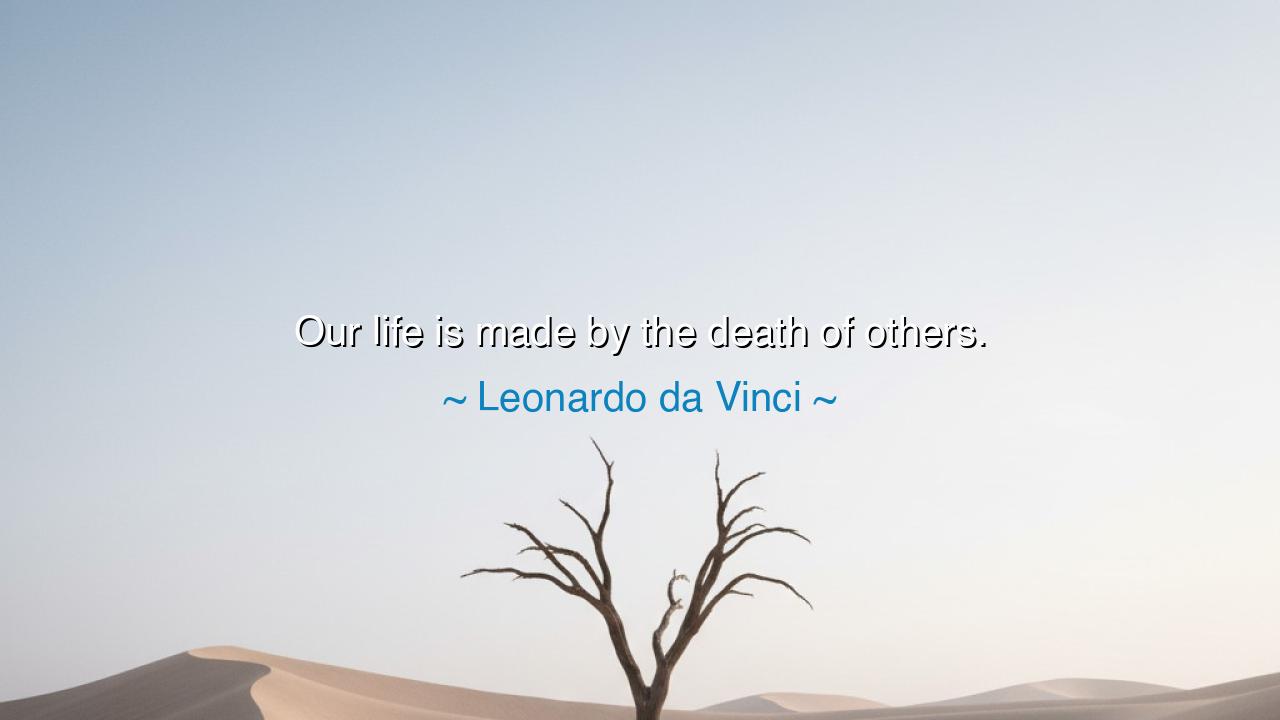
Our life is made by the death of others.






“Our life is made by the death of others.” Thus spoke Leonardo da Vinci, the eternal thinker — painter, inventor, anatomist, philosopher — whose eyes beheld the world not only in its beauty but in its brutal truth. In this brief and haunting reflection, Leonardo reveals the deep and often uncomfortable law that binds all living things: that life and death are inseparable, that the breath of one creature is sustained by the silence of another. It is the great cycle — the rhythm of existence — where birth arises from decay, nourishment from sacrifice, and the living are forever indebted to the dying.
To Leonardo, this was no mere poetic fancy, but an observation drawn from the deepest wells of science and spirit. He saw it in the anatomy of man, where muscles feed on the lives of beasts; in the forest, where fallen leaves feed the roots that will one day bear fruit again; in the battlefield, where the ambition of kings is nourished by the blood of soldiers. To live, he understood, is to consume — not only the food of the body, but the labor, the sacrifices, and even the mortality of others. He looked upon this not with guilt, but with reverence, as one who saw the unity behind the apparent cruelty of nature. For death, in Leonardo’s vision, was not the end — it was the fuel of creation, the silent architect of renewal.
The ancients, too, knew this truth. The Egyptians depicted Osiris, god of death, as the lord of fertility — the one who died so that the grain might grow again. The Greeks told of Persephone, who descended to the underworld each winter and returned each spring, her absence marking the death of the fields, her return their rebirth. In every ancient myth, death was never an enemy, but a partner — the hidden twin of life. Leonardo, inheritor of this wisdom, spoke as both artist and sage when he said that our life “is made” — not merely sustained — by the deaths of others. For through their passing, something new is born: the grass that nourishes the lamb, the lamb that feeds the man, the man whose work and love shape the world for those who come after.
Yet this truth is not only about nature — it is also moral, even spiritual. Every comfort we enjoy, every freedom, every lesson, is built upon the sacrifices of those who came before. The food we eat costs the life of another creature. The peace we live in was purchased by the struggles of our ancestors. The knowledge we hold was earned through the trials and errors — and often the suffering — of generations past. To forget this is to live in arrogance; to remember it is to live in gratitude. When Leonardo spoke, he was not glorifying death, but awakening the soul to reverence — to the awareness that all life is a sacred exchange, that every gift we take demands humility and care in return.
Consider the story of the fallen soldiers of Thermopylae, who stood against the armies of Persia knowing they would not return. Their death was not in vain; it preserved the freedom of their people and the legacy of a civilization that would shape the Western world. Their sacrifice, like the countless unnamed who followed in history’s long march, reminds us that our life is made by their death — that we stand today upon the bones of the brave, the forgotten, and the selfless. So too, the farmer whose calloused hands plant the seed, the mother who endures pain to bring forth a child, the teacher who spends her life igniting the minds of others — each, in some way, gives a portion of themselves so that others may live more fully.
Leonardo’s reflection also holds a mirror to our moral duty. If our life is made by the death of others, then we must live in such a way that honors their loss. We must not squander the sustenance given by the earth, nor the sacrifices made by human hands. To eat is to owe gratitude; to live is to owe purpose. Every breath is borrowed, every heartbeat a gift purchased by the turning of the great wheel of mortality. To live wisely, then, is to give back — to add beauty, kindness, or truth to the world that has sustained us, so that others may one day draw life from our labors as we have from those before us.
Lesson: Walk gently upon the earth. Eat with gratitude. Labor with honor. Love with awareness of the fragile thread that binds all living things. Remember that every comfort, every breath, every moment of joy is not yours alone — it is part of a great inheritance paid for by the sacrifice of others, both seen and unseen. Do not take lightly what others have given their lives to preserve.
So, remember the wisdom of Leonardo da Vinci, who saw through the veil of existence into its eternal pattern: that life and death are not opposites, but dancers entwined in an endless embrace. One gives, the other receives; one ends, the other begins. To live, therefore, is to participate in this sacred rhythm — to accept the gift of life with reverence, to honor the dead with gratitude, and to leave behind something worthy of those who will, in turn, draw their life from yours.






AAdministratorAdministrator
Welcome, honored guests. Please leave a comment, we will respond soon